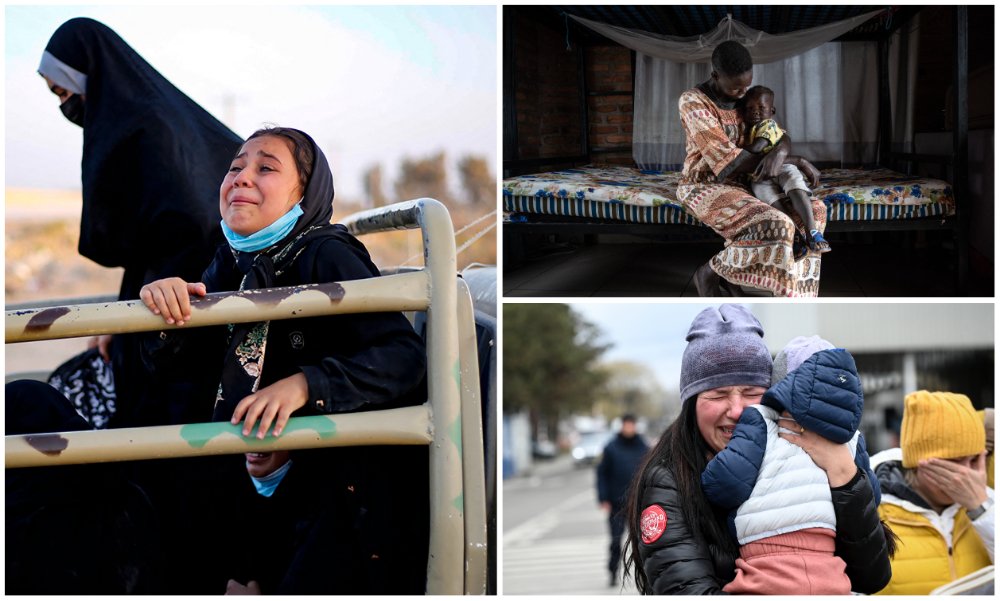NEW YORK CITY: Nearly half of the world’s forcibly displaced people are still children under 18-years-old, according to data published by the UN refugee agency — that is 1.5 million more people than the entire population of Saudi Arabia.
It is an old problem, but it is not going away.
By the end of 2021 the UNHCR data put the number of forcibly displaced people of all ages as a result of persecution, conflict, violence, human-rights violation or events seriously disturbing public order, globally at 89.3 million. This has risen to 100 million since the Russian invasion of Ukraine in March.
“The situation with the forcibly displaced is very, very worrying,” Raouf Mazou, assistant high commissioner for operations at UNHCR, told Arab News on the sidelines of the UN General Assembly in New York.
“To this year we came to a total number of about 100 million people forcibly displaced. These include refugees and internally displaced people.”
But even with the figures released in June, the 42 percent of children forced out of their homes stands at approximately 37,506,000.
To give this some perspective, that is 15,756,000 more than the entire population of Cairo, nearly five times the number of people in Riyadh, and nearly 28 million more people than London.
Moreover, the problem is growing. While many children and adults — usually women — were forced from their homes by drought, food insecurity and armed conflict, there are also 1.5 million children who were born as refugees.
Annually, between 2018 and 2021, this equated to an average of between 350,000 and 400,000 children born into a refugee life each year. Whether on their own or with family, all face food insecurity, poverty and threats to their safety.
“If one looks at the past 10 years, we’ve seen every year an increase in these numbers,” Mazou said.
In turn, this exposed them to increased vulnerability and attacks, often violent sexual assaults. The victims range from children to adults, the attackers operate alone and in groups.
Gang rapes have become worryingly common in South Sudan as the flimsy truce moves closer to complete failure.
“That is as a result of conflict, as a result of climate, as a result of a number of reasons. It’s a very (concerning) situation,” Mazou told Arab News.
On Monday Martin Griffiths, the UN under-secretary-general for humanitarian affairs and emergency relief coordinator, told the Security Council that hunger is being used as a “tactic of war,” something humanitarian organizations are trying to combat through lifelines, by working with local groups who are the first, sometimes only, “responders on the ground.”
He warned that the presence of humanitarian aid workers does not spell the end of suffering for those displaced.
South Sudan is “one of the most dangerous places to be an aid worker last year, with 319 violent incidents targeting humanitarian personnel and assets.”
Griffiths said five aid workers were killed in 2021 — five more have died since the beginning of this year.
Up until the Russian invasion of Ukraine, a big majority of refugees — 69 percent of the global number, to be precise — originated from just five countries, notably Syria, South Sudan and Afghanistan.
In Syria more than 6.9 million people have fled their homes internally, and more than 6.5 million remain outside Syria, of whom 5.7 million are refugees in the region, still being hosted by neighbours. Up until Ukraine happened, Syria accounted for the highest number of displaced people.
Currently 14.6 million people in Syria rely on aid — 1.2 million more than a year before. More than 90 percent of Syrians live in poverty.
After 11 years of conflict, those displaced by the Syrian war are beginning to become a forgotten cause.
“There’s always an element of asylum fatigue,” Mazou said. “Because after some time, people expect that the solution would be resolved and therefore, there is less attention. And then you see a reduction in the funding.”
According to him, the events of 2021, such as the war in Ukraine and the violent regime change in Afghanistan, have pushed Syria even further out of the limelight.
“Each of these new situations require additional funding and reduce the availability of funds for other locations,” Mazou said.
He said the ripple effect has been an increase in the amount of need.
“The resources that are being mobilized are not increasing as fast as the number of refugees and the amount of need that we have,” he said.
Among the issues faced by refugees is gender-based violence and risks to children, which are on the rise.
Then there is the food-security crisis, which has set new records with 13.9 million people going hungry every day, and is being aggravated by the conflict in Ukraine.
“We have about 11 million refugees in 42 countries, which are dependent on food assistance,” Mazou said.
“And what we are seeing now is that in a number of countries, we do not have enough resources.”
He said the cost-of-living crisis had exacerbated the problem, meaning the amount of food being made available was decreasing as costs soared.
The situation is so bad, according to Mazou, there are refugees who are receiving little or no food assistance.
The problem is not just food scarcity, though. One of the first things child refugees lose is access to education.
Nearly one-in-two Syrian children are out of school and vulnerable to child labour, early and forced marriages, trafficking, and recruitment by armed actors, according to UNHCR data.
Mazou said just 37 percent of all refugee children have access to secondary education, while those in tertiary education amount to just 6 percent of those who need it.
“The problem is that less access to education means that they are less prepared and ready to be part of the country when they are able to go back. So, definitely one can speak of a lost generation,” he said.
Mazou said the UNHCR is in ongoing discussions with governments to ensure that refugee children are included in existing education systems.
According to the UNHCR Data Finder report, a vast majority of those people forcibly displaced from their homes and countries are hosted by low- and middle-income countries — not richer Western ones.
“Low- and middle-income countries host 83 percent of the world’s refugees and Venezuelans displaced abroad,” the report said, adding: “The least developed countries provide asylum to 27 percent of the total.”
Many Syrian refugees who left the country during the war now find themselves in Turkey, Lebanon, Jordan, Iraq and Egypt.
It is well documented that Lebanon, a country the size of the British county of Cornwall and with a population of four million, hosts somewhere in the region of 2 million known refugees.
Lebanon is in a financial crisis of its own where banks are denying citizens access to their own savings.
It is clear that the cost-of-living crisis has hit funding for refugees significantly in the past three years, with the pandemic and the Taliban takeover of Afghanistan forcing millions to flee.
In its 2021 donor impact report, the UNHCR said: “2021 was another difficult year.”
It went on to add: “Economic crisis, conflict, climate change, and the ongoing COVID-19 pandemic have demanded that we adapt to new challenges every day.”
“But the trials and tribulations of 2021 especially impacted some of the world’s most vulnerable people: the over 84 million forced to flee their homes to escape war, persecution, and other life-threatening situations.”
In January, 2022, the UN Relief and Works Agency for Palestine Refugees in the Near East (UNRWA) announced it was seeking from the international community $ 1.6 billion this year.
UNRWA was established by the General Assembly in 1949, mandated to provide assistance and protection to 5.7 million Palestine refugees registered with the agency across its five fields of operation.
UNRWA’s mission is to “help Palestine refugees in Jordan, Lebanon, Syria, West Bank, including East Jerusalem and the Gaza Strip achieve their full human development potential, pending a just and lasting solution to their plight. UNRWA services encompass education, health care, relief and social services, camp infrastructure and improvement, protection and microfinance.”
In January Philippe Lazzarini, UNRWA commissioner-general, said the international community recognized the “lifesaving role of UNRWA” and its role in contributing toward stability in the Middle East.
“In 2022, that recognition must be supported by the adequate level of funding to meet this critical moment for Palestine refugees,” he said.
“Chronic agency budget shortfalls threaten the livelihoods and well-being of the Palestine refugees that UNRWA serves and pose a serious threat to the Agency’s ability to maintain services.”
Earlier in September Lazzarini concluded an official visit to Cairo during which he met with Ahmed Aboul Gheit, the secretary-general of the Arab League, and Sameh Shoukry, Egypt’s foreign minister.
Commending Egypt and the Arab League for their political support, he called for continued Arab solidarity with Palestine refugees, not least in their financial support of the UNRWA.
“But it requires adequate resources to implement the mandate that this region, and most of the world, gives it,” Lazzarini said. “Political support — without matching financial resources — will not cover the cost of 700 schools, 140 health centres, and food and cash assistance for over two million poor and conflict-affected Palestine refugees.”
It is no different for the UNHCR, said Mazou, who explained that while the pandemic has seen an increase in donations both from the private sector and individuals – likely driven by their own newly found hardship — the needs continue to grow.
“There are a number of situations — in Yemen for instance, where you have 5 million internally displaced people, plus about 100,000 refugees in a situation where there’s been conflict for quite some time,” Mazou told Arab News.
“It’s clear that financial support is required and also support to deal with the root cause of the conflict, which have, as an impact and as a consequence, displacement. So more financial resources are needed for sure.”
Mazou praised GCC member states for their contributions to the refugee cause, but added: “You can never be satisfied with the level of contributions we are receiving right now.”
Pointing out that the UNHCR’s global budget is around $10 billion, he said: “We normally get half of it as contribution, so we already have a gap globally.”
Addressing GCC countries, he said “Whether it is UAE, whether it is Saudi Arabia, whether it is Qatar, they have been contributing. But of course they need to contribute more.”
It is not a question of being ungrateful, Mazou explained. “This is what we ask all our donors, we appreciate what they do, but we ask for more.”




